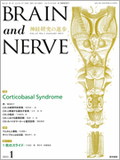Japanese
English
- 有料閲覧
- Abstract 文献概要
- 1ページ目 Look Inside
- 参考文献 Reference
はじめに
大脳基底核変性症(corticobasal degeneration:CBD)と思われる臨床例の記載は,少なくとも1925年のLhermitteらによる報告までさかのぼり1),病理学的には腫大神経細胞を認めるがピック嗜銀球を認めないピック病として認識されていた(ピック病グループBとされていた疾患に相当2))。臨床像,病理像を一疾患単位として両面から記載したのは,1967,1968年のRebeizら3,4)が初めであり,臨床的に緩徐進行性に左半身優位の巧緻運動障害,寡動,不随意運動,皮質性感覚障害や失行などを呈し,末期まで認知機能障害は明らかでなかった3例の剖検例について報告している。病理学的所見としては前頭葉,頭頂葉の左右差のある萎縮,皮質および黒質,視床下核,歯状核,室頂核などの神経核の神経細胞脱落,反応性グリオーシス,腫大した無色素性神経細胞(swollen achromatic neuron,ballooned neuronと呼ばれる)の存在などの特徴を挙げ,既知の疾患概念に当てはまらない独立した疾患として“corticodentatonigral degeneration with neuronal achromasia”と名づけた4)。
その後しばらく,類似症例の報告は少数であったが1989年から1990年にかけて臨床像,病理像が再評価され,歯状核病変より基底核病変の重要性が強調されてcorticobasal degeneration5),cortical-basal ganglionic degeneration6)あるいはcorticonigral degeneration with neuronal achromasia7,8)として報告が相次いだ。以降,分子病理学の進歩によりCBDは,進行性核上性麻痺(progressive supranuclear palsy:PSP),ピック病(以下,病理学的にピック嗜銀球,腫大神経細胞を認めるものを表す言葉として使用),嗜銀顆粒病(argyrophilic grain disease)などと同様に,神経細胞,グリア細胞(星状細胞および乏突起膠細胞)にタウ蛋白が蓄積する疾患(タウオパチー)であるが9,10),特に星状細胞においては“astrocytic plaque”としてCBDに特徴的な蓄積形態を示すことが明らかになった11,12)。生化学的には蓄積するタウ蛋白のアイソフォームはピック病では3リピートタウ,CBDとPSPでは4リピートタウ(詳細後述)が主体であり13,14),さらに不溶性分画内のタウ分解産物のパターンがCBDとPSPでは異なることが明らかになった15)。
上記のように多方面からCBDに固有の病理学的特徴が明確に確立された一方で,その臨床像は非常に多彩であることも明らかとなり5-8,16,17),逆にRebeizらの報告に類似する古典的な臨床像,つまり片側優位の前頭・頭頂葉皮質に由来する運動・感覚症状および錐体外路症状を呈する例において,病理像,起因疾患が多彩であることも明らかとなってきた18-22)。このように“CBD”が表す臨床的概念と病理学的概念が一対一対応しないことから,近年では古典的な臨床像に対する臨床診断名としてCBS(corticobasal syndrome)を用い,病理診断名としてCBDが用いられるようになっている。CBSと類縁疾患の関係をFig.1に示す。
Abstract
Corticobasal syndrome (CBS) is a clinical syndrome presenting with progressive asymmetric bradykinesia, rigidity, and dystonia accompanied by cortical signs, such as apraxia, alien limb phenomena, cortical sensory loss, myoclonus, and mirror movements. CBS is associated with different pathological conditions including FTLD-tau (corticobasal degeneration, CBD; progressive supranuclear palsy, PSP: and Pick disease), FTLD-TDP, Alzheimer disease, Creutzfeldt-Jakob disease, and Parkinson disease/dementia with Lewy bodies. Among these, the most common pathology is CBD. In patients with familial and sporadic FTLD, MAPT, GRN and C9orf72 mutations are the three main causes of the disease, even though the C9orf72 mutation is rare in Japan. Patients with MAPT mutations present with FTLD-tau, and patients with GRN and C9orf72 mutations exhibit FTLD-TDP. FTLD is also associated with VCP, CHMP2B, TARDBP and FUS mutations, but each of these account for <1% of familial FTLD cases. In sporadic cases, the H1c haplotype and the rare p.A152T variant of MAPT are known to be associated with FTLD-tau, and the common genetic variant (rs5848) in the 3'-UTR of GRN is associated with FTLD-TDP. A recent genome-wide association study identified TMEM106B as a potential risk-modifying factor for FTLD-TDP, and STX6, EIF2AK3 and MOBP, for PSP. Despite major advances in genetic studies in recent years, the majority of sporadic CBS cases are genetically unsolved. Further studies are needed to unveil the genetic background of CBS. In this review, we discuss the recent advances related to the genetics of CBS, particularly about the genetics of FTLD.

Copyright © 2013, Igaku-Shoin Ltd. All rights reserved.


